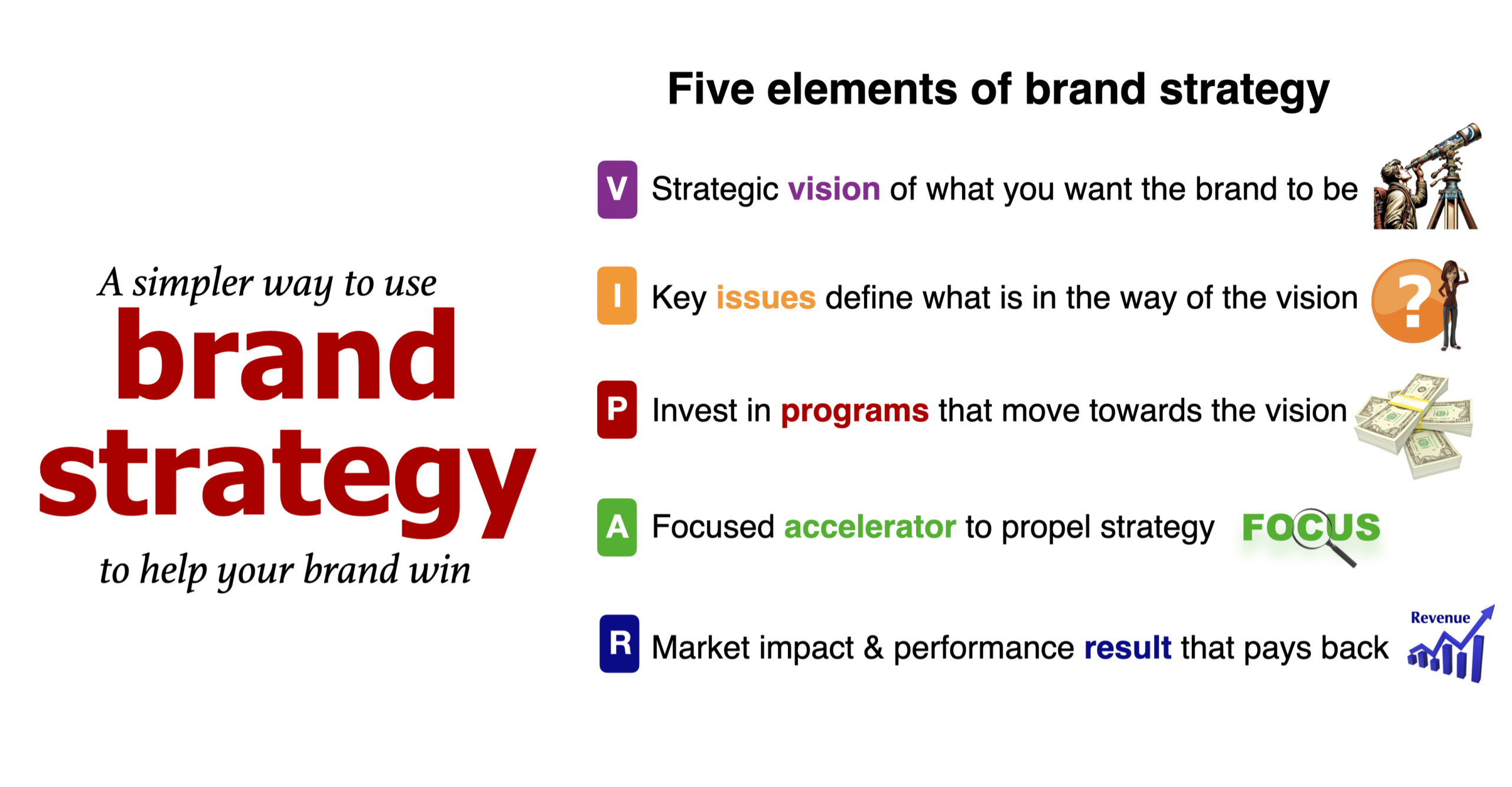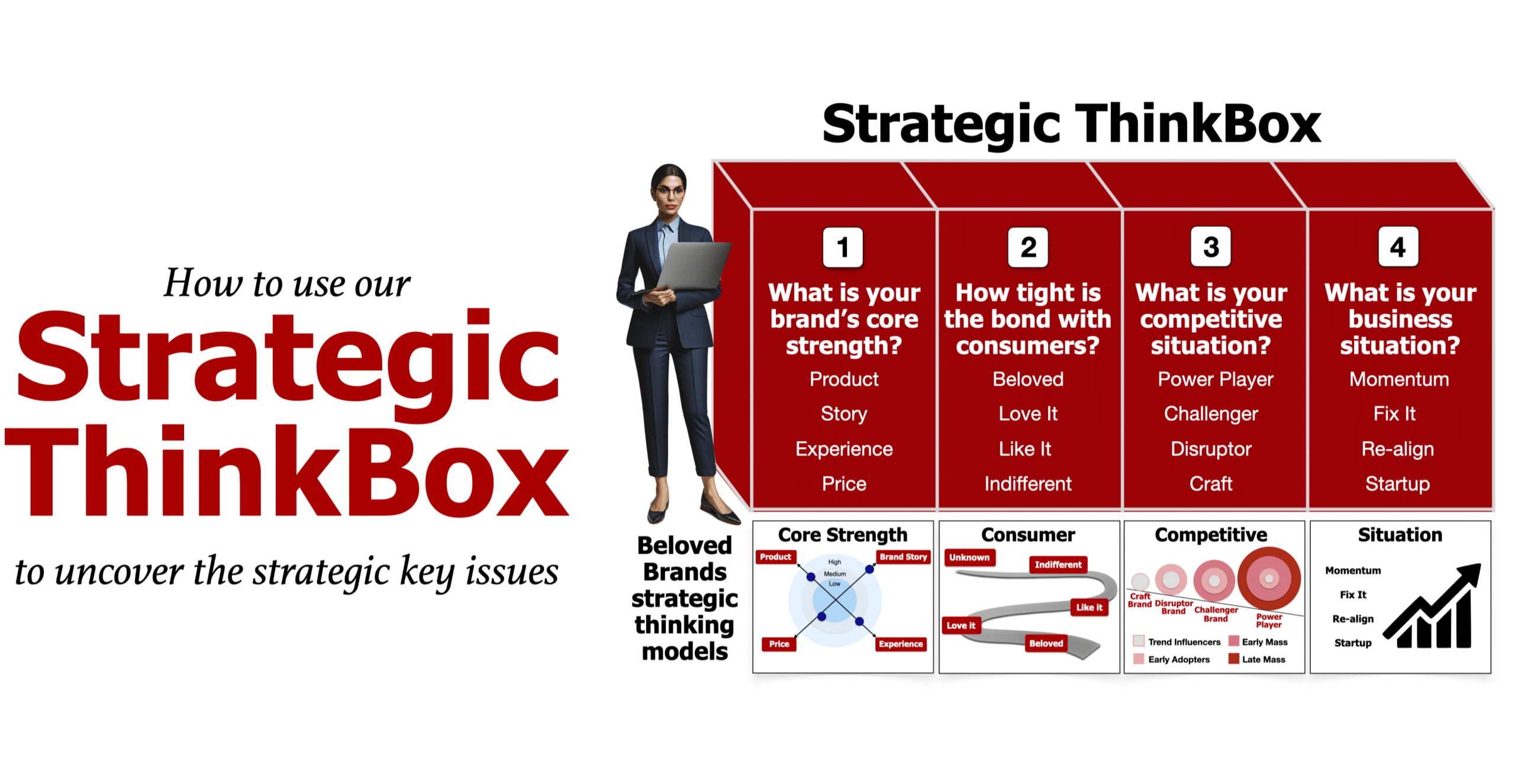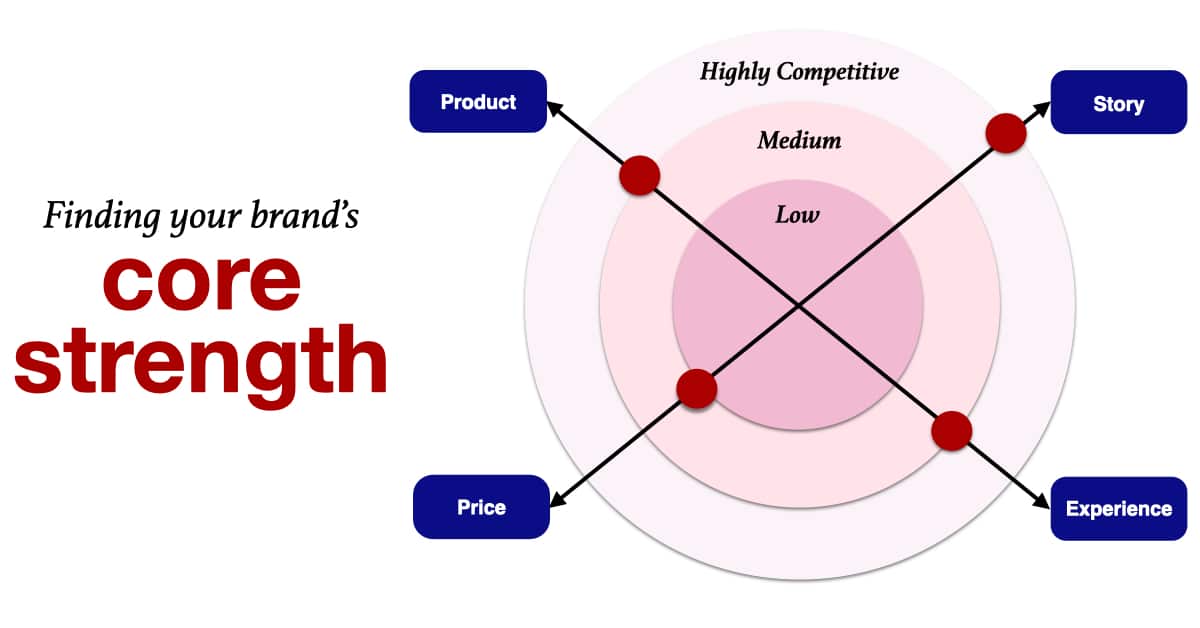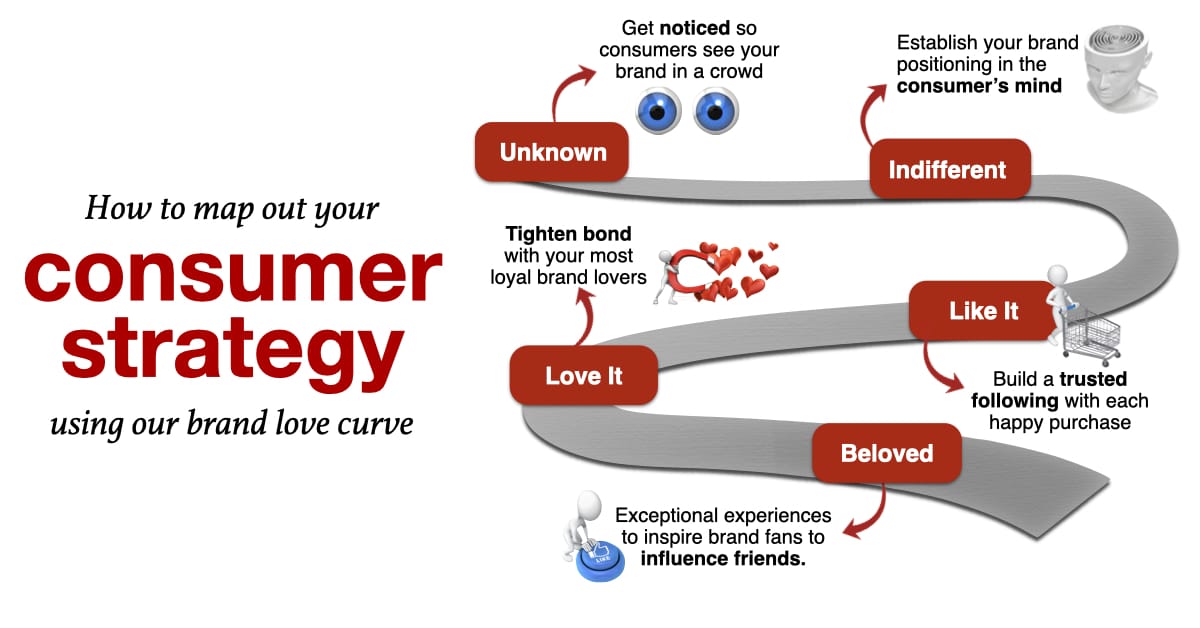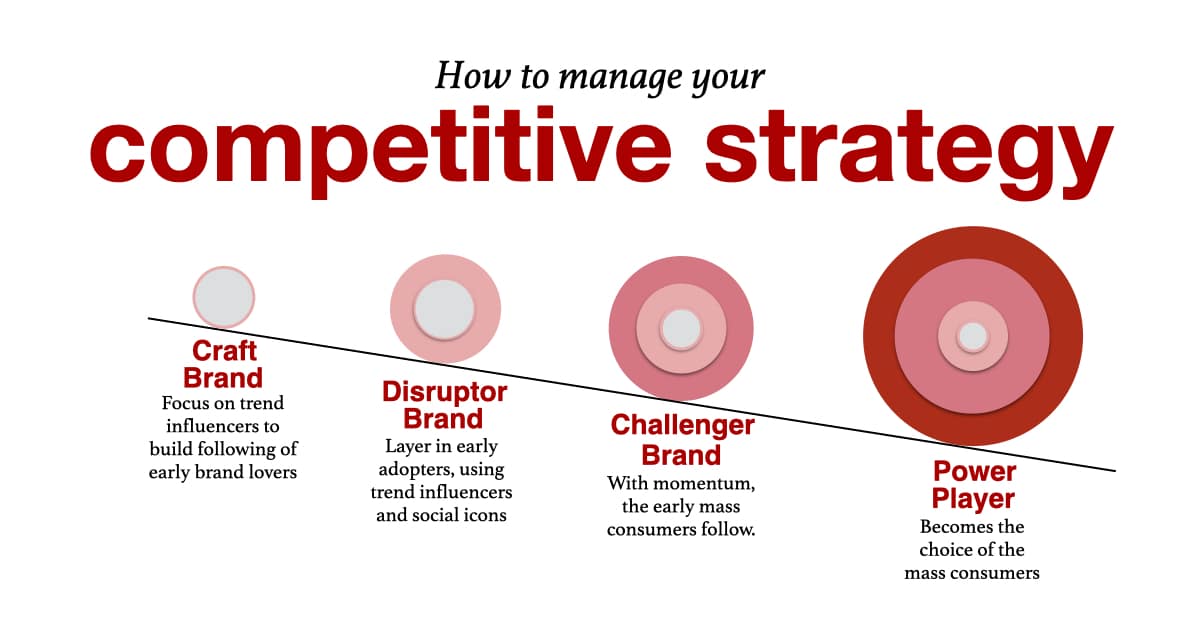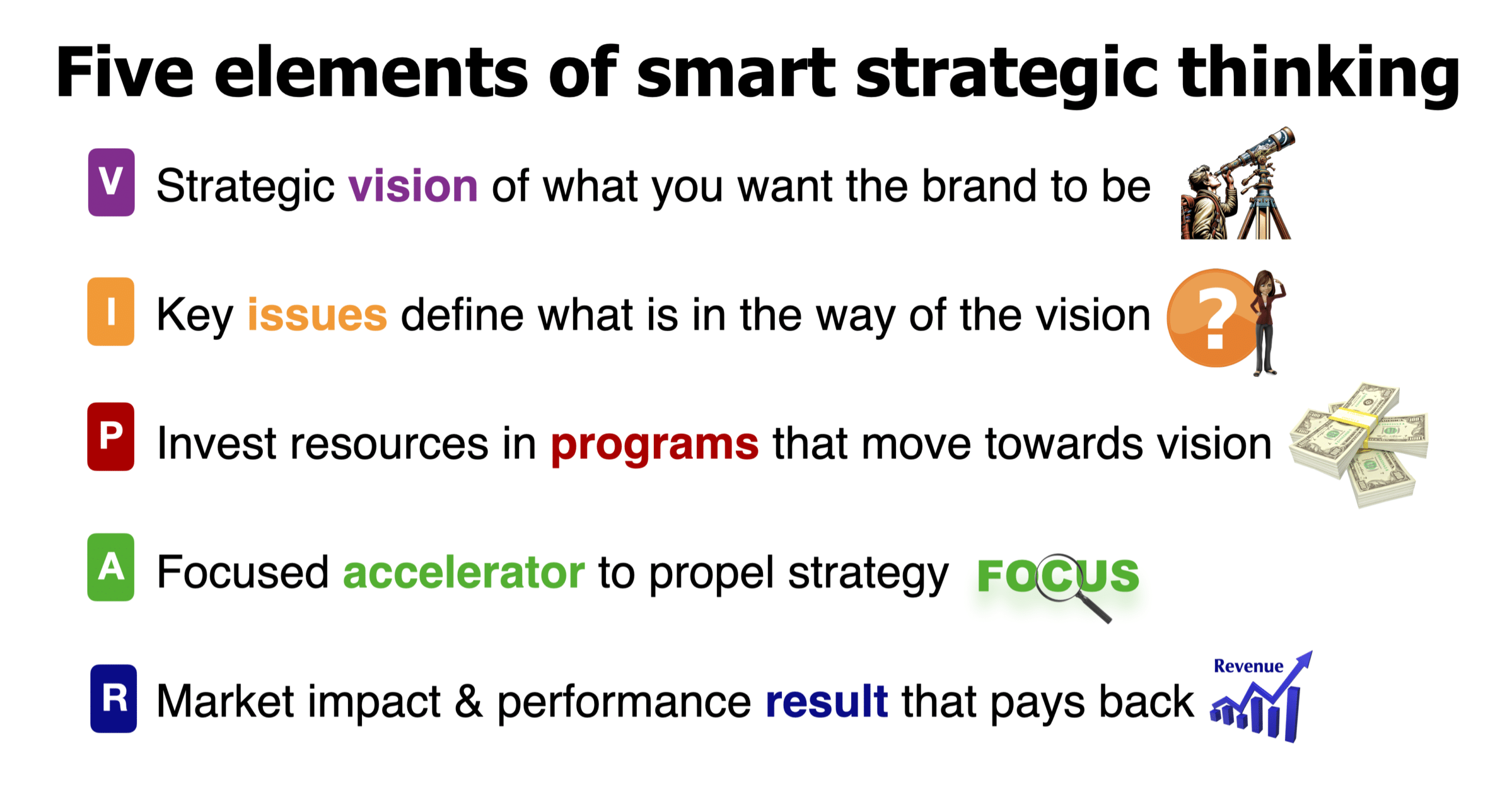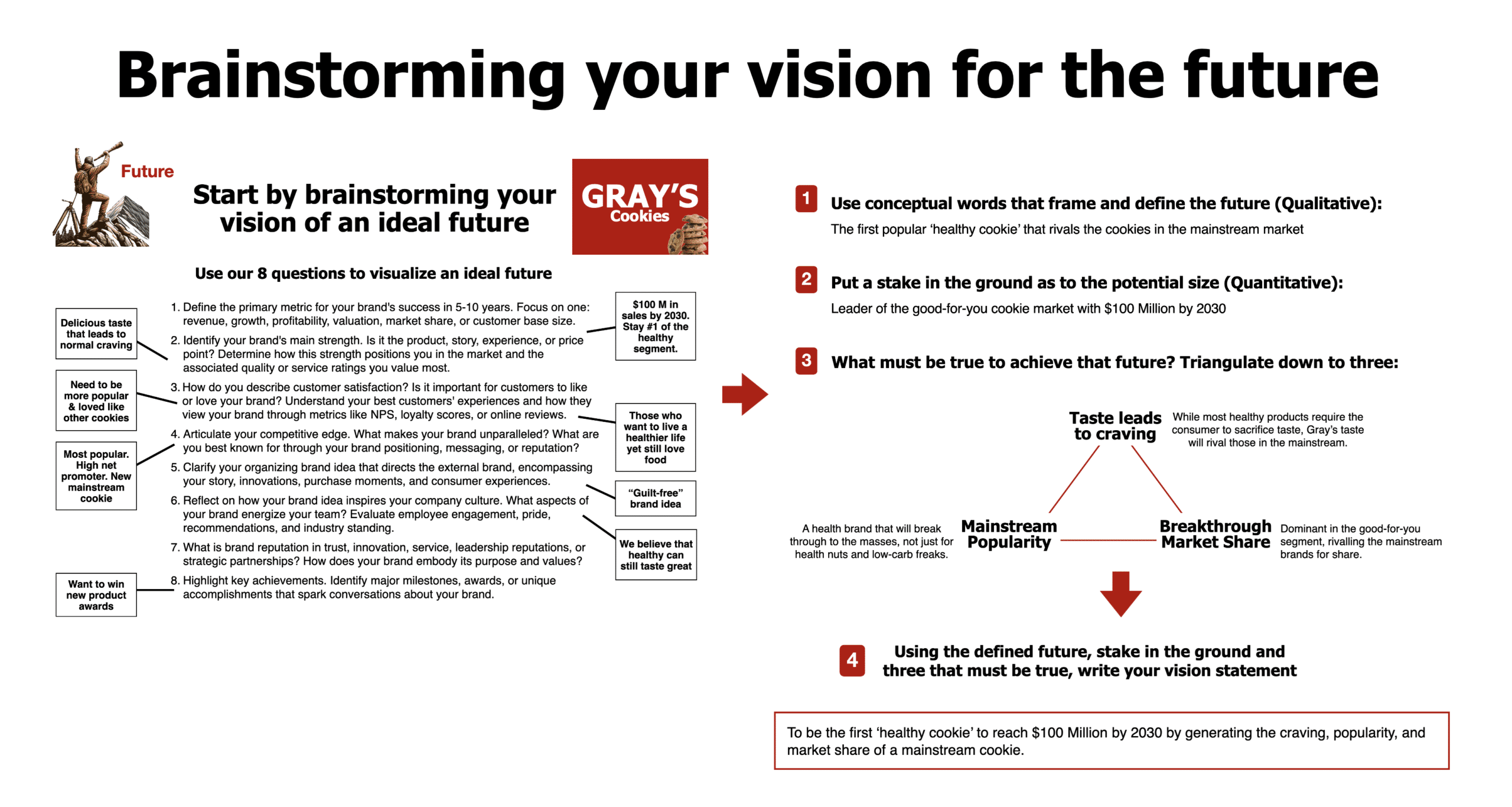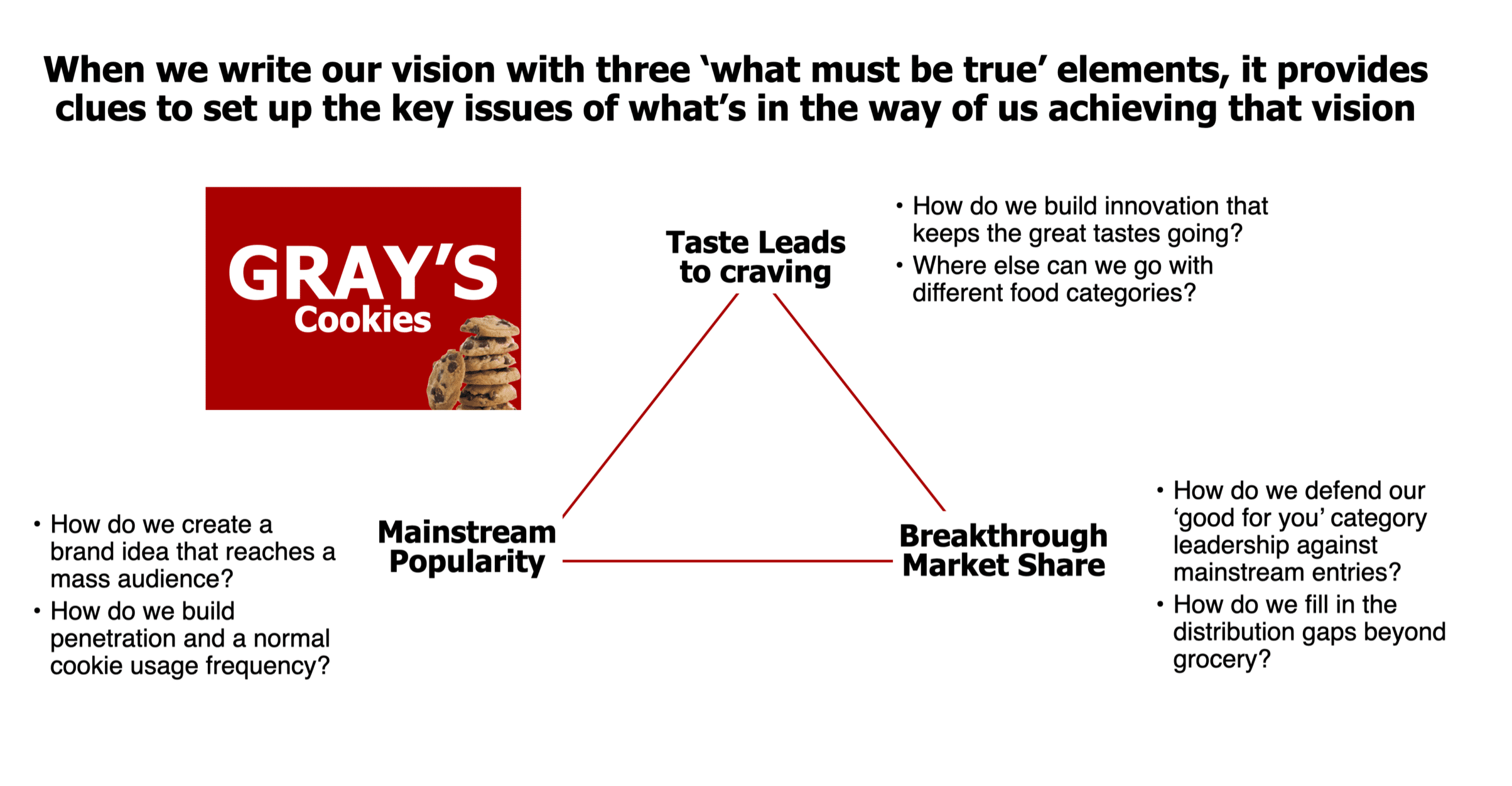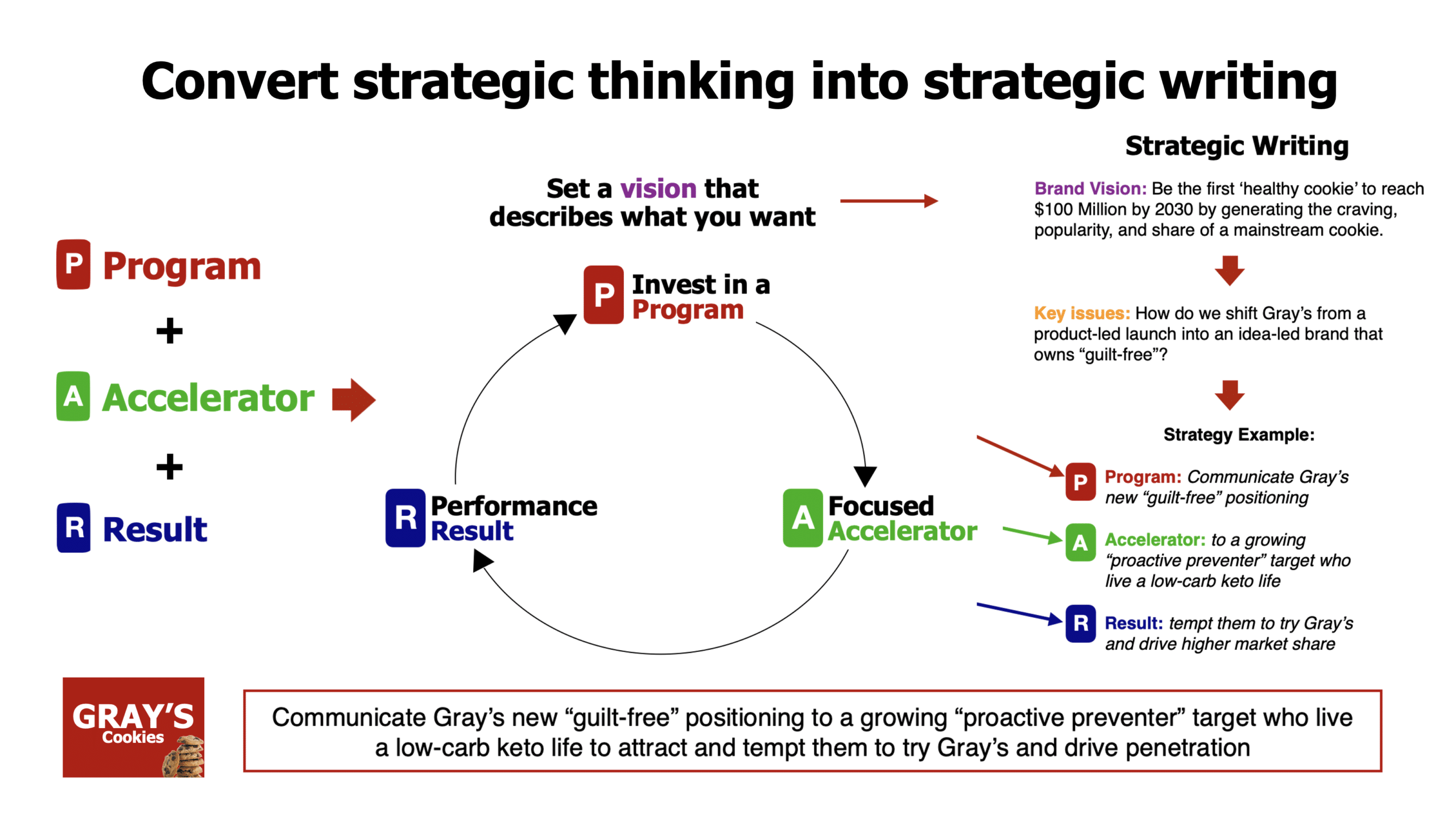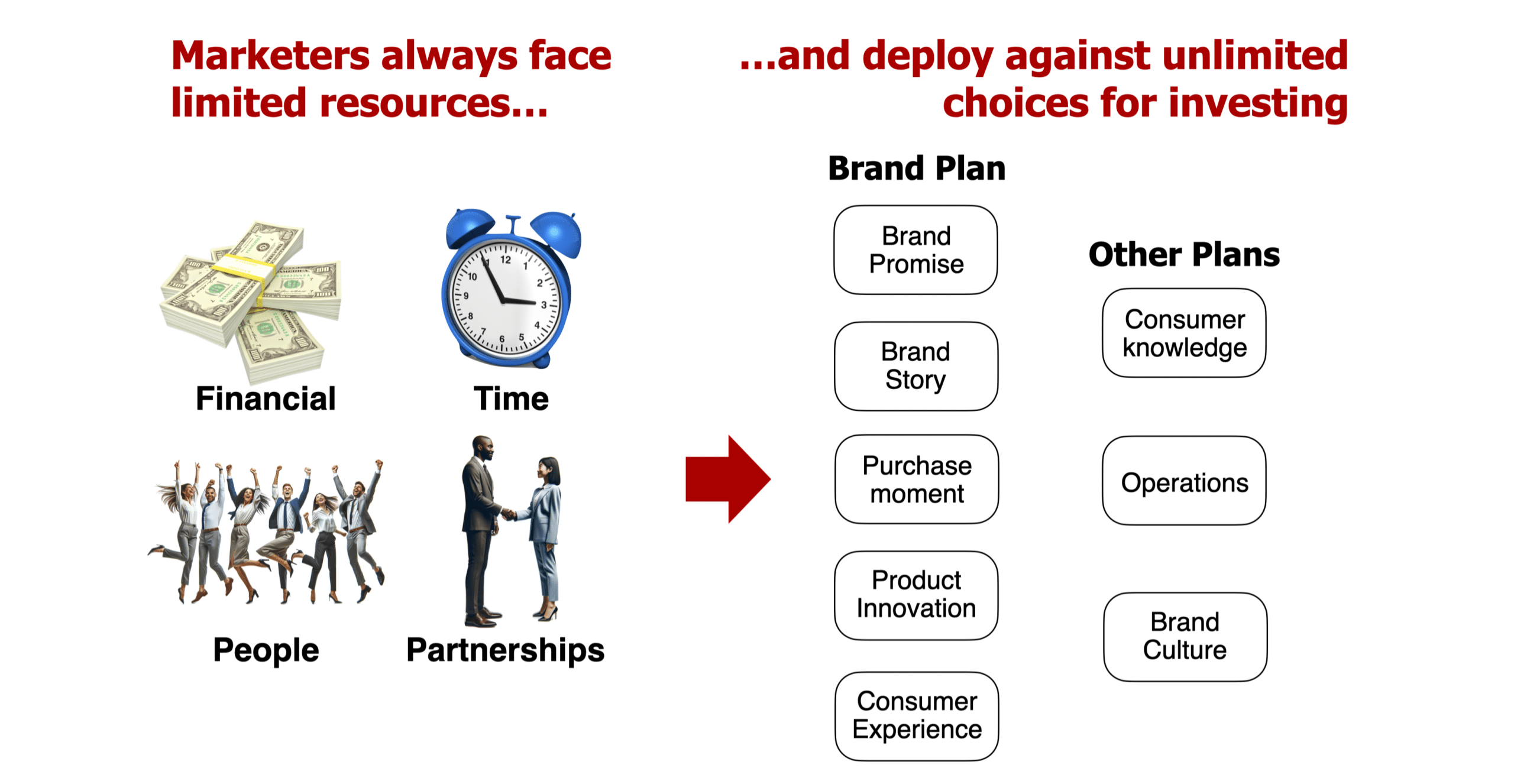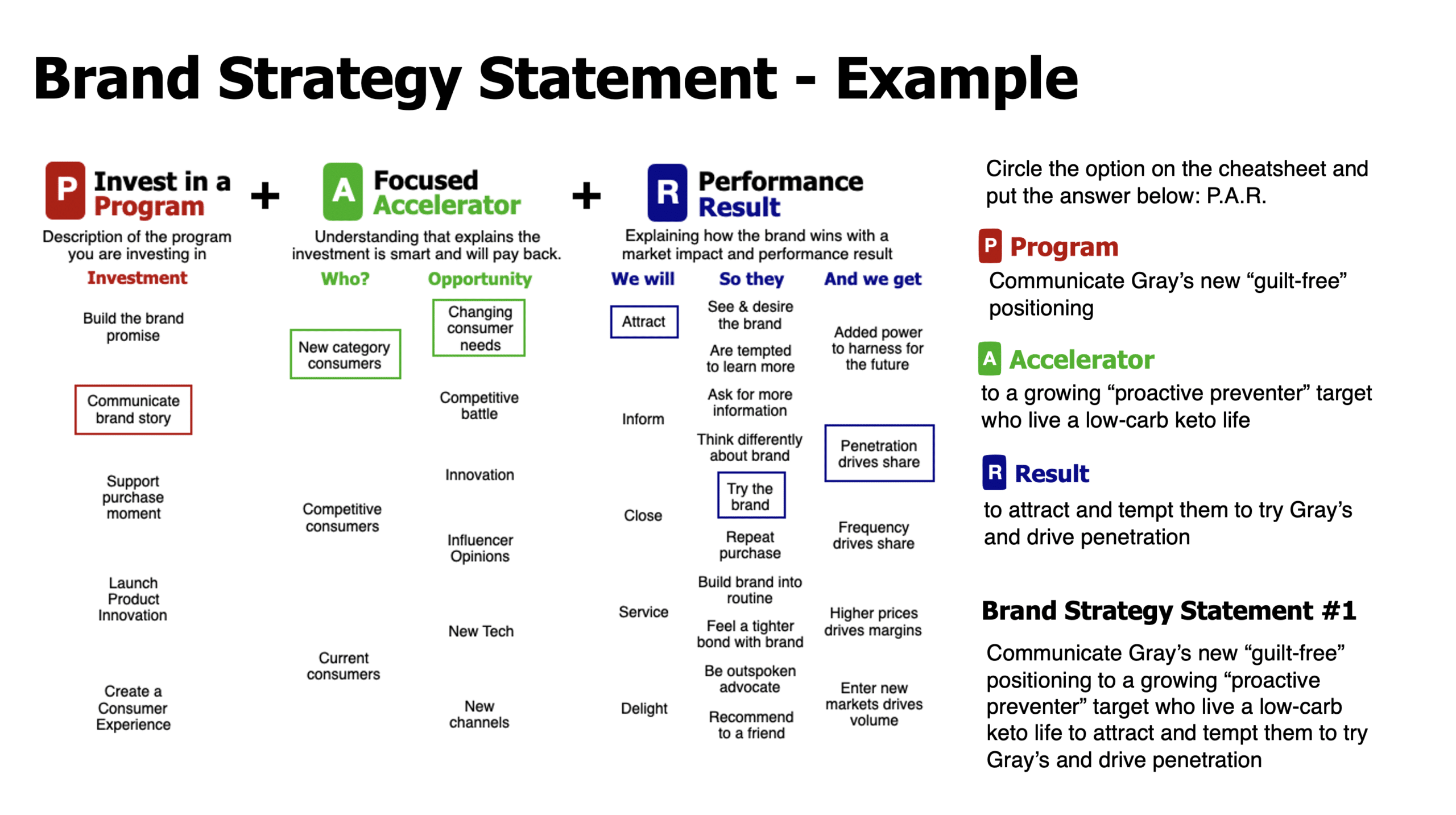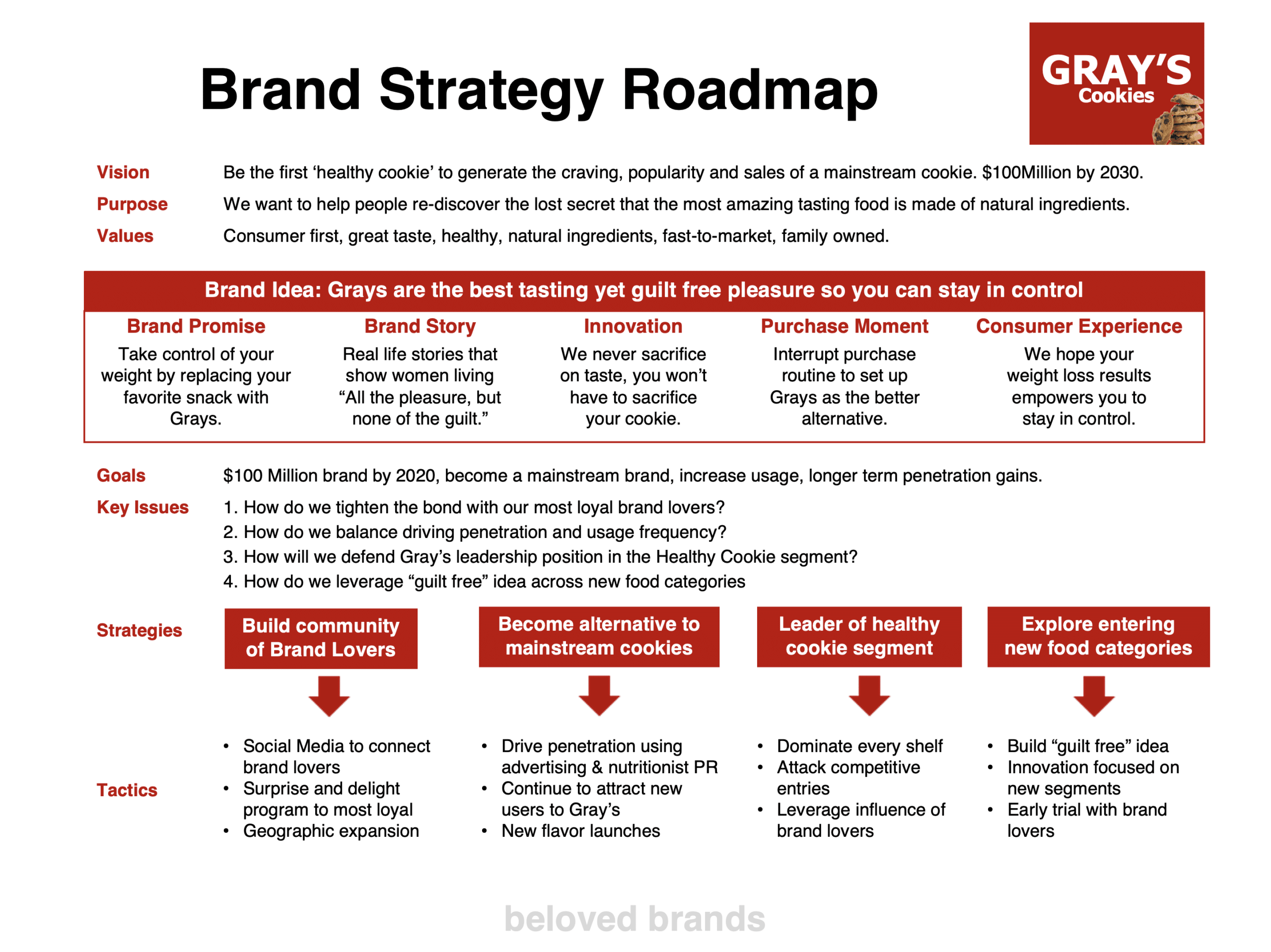I hate when marketers overly complicate brand strategy. They mistakenly consider strategy the more intellectual part of business, so they use big, vague words to try to sound smart. The people who execute don’t know what words mean. We will explore how our Strategic ThinkBox can trigger deeper strategic thinking and help develop the best key questions facing your brand. Then, we will use our Five Strategy Elements – vision, key issues, programs, accelerator, and result – to structure and communicate your brand strategy statements. For brand strategy to work, you must be able to cascade your words throughout the organization.
We use two strategic thinking tools: Our Strategic ThinkBox will trigger deeper thinking. Our Five Strategy Elements help you organize and communicate your thinking.
To illustrate, click the image above to see how the strategic elements will trigger your strategic thinking.
Our Strategic ThinkBox and Marketing PlayBox
I am introducing you to my ThinkBox and PlayBox concepts, which I have borrowed from sports. To start, the ThinkBox forces you to consider everything you face and develop your shot strategy before taking the shot. For instance, in golf, you need to look at any lakes or bunkers in the way, the wind condition, or how well you are playing that day, and then decide on your shot strategy.
Then, as you move to a PlayBox during the execution, you must visualize the ideal shot, think and feel your way through the mechanics of your swing, and trust you are making the right shot. Avoid overthinking the strategy during the execution.
To illustrate, click the image above to see how our Strategic ThinkBox will trigger your strategic thinking.
In managing your brand, use our Strategic ThinkBox to get a 360-degree view of the brand’s situation before taking action. It forces you to look at four specific areas: Your brand’s core strength, your bond with your consumers, your brand’s competitive position, and your brand’s business situation. The four areas of the Strategic ThinkBox are designed to challenge and trigger new thinking and get you to debate with your team.
Once you have completed your thinking, use the Marketing PlayBox to keep your marketing execution focused on the target, fit with the brand, deliver the brand message, and execute the strategy. The Marketing PlayBox allows you to use your instincts to find the best execution ideas and to think, feel, and trust your way through the execution.
The four questions in our Strategic ThinkBox
As I created the Strategic ThinkBox, I made it so that each of the four questions uses a forced choice to make decisions, where you must focus on only one possible answer for each question.
- What is the core strength that will help your brand win?
- How tightly connected is your consumer to your brand?
- What is your current competitive position?
- What is the current business situation your brand faces?
To illustrate, click the image above to see how our Strategic ThinkBox will trigger your strategic thinking.
Using the Strategic ThinkBox to discover the key issues
1. What is your brand’s core strength?
Think of your core strength as your brand’s superpower or secret sauce that separates you from other brands. Is it your product, brand story, consumer experience, or price? Your core strength steers your entire strategy, including the brand messages and the focus of your investment. In the next chapter, I show a unique process for how to choose your brand’s core strength and then show you how to write smart, strategic objective statements around your core strength.
The core strength of Gray’s Cookies
Gray’s Cookies started as a product-led brand but met a ceiling on growth. The market is cluttered. There are signs the product has been fully accepted, but the brand idea has yet to connect. Gray’s cannot gain enough share if perceived as the next best product. The open space is an idea that combines the physical and psychological elements of diets—focusing the brand story on helping get past the guilt of cravings. How do we communicate our story so we own it? In conclusion, Gray’s wants to move their core strength from product to brand story—to build on the “guilt-free” idea.
As we frame this issue into a question, it becomes: How do we shift Gray’s from a product-led launch into an idea-led brand to own “guilt-free?”
To illustrate, click the image above to see how our core strength model will trigger your strategic thinking.
2. How tight is the bond with consumers?
Start by determining where your brand currently sits on the brand love curve, whether your brand is unknown, indifferent, like it, love it, or at the beloved stage. The goal is to tighten the bond with your consumer and move them from one stage to the next. In a later chapter, I will show you how to use brand funnel data, the voice of the consumer, and market dynamics to determine where your brand sits on the brand love curve. I will outline clear game plans for each stage.
The consumer situation for Gray’s Cookies
Like many new brands, Gray’s Cookies has some consumers who love them already, but with the vast majority of the market, Gray’s is rather unknown. Even with those who love, stated loyalty is high, but usage frequency is far below the mainstream cookies. Do we focus our investments on getting more new consumers, or do we get our current fans to use more? How do we use our brand fans to create more awareness? In conclusion, Gray’s has a very small base of consumers who love them. Still, they need to figure out how to cultivate the love of happy consumers and reputation to influence other consumers, who currently see the brand as relatively unknown.
Turning that into a key issue question, it becomes: How do we drive consideration and trial to establish the brand in the consumers’ minds?
To illustrate, click the image to see how our consumer strategy model will trigger strategic thinking.
3. What is your competitive situation?
Regarding the competitive strategy, you must choose from one of four competitive situations in which your brand operates. The dominant leader in the category is the power players, who take a competitive defensive stance. The challenger brands have gained enough power to battle with the market leader head-to-head. The disruptor brands have found a space so different they can pull consumers away from the significant category players. Craft brands aggressively go against the category with a niche target market and a niche consumer benefit. They are small and stay far away from the market leaders. Each competitive situation leads to different strategy choices.
The competitive situation for Gray’s Cookies
Gray’s has quickly disrupted the cookie category, capturing the consumer shift to healthier alternatives. Gray’s has become the dominant power player brand in the ‘good-for-you’ cookie segment. However, there are rumors that the mainstream (Nabisco, Pepperidge Farms) cookies are looking to enter with healthier alternatives. How do we hang onto our share? Do we attack or defend? What will be the source of the defense plan? In conclusion, Gray’s recipe has helped disrupt the cookie category. Consumers have been highly responsive, and Gray’s has stolen a significant share. Now, the concern is the reaction of the big power player mainstream brands.
Turning that conclusion into a key issue question, it becomes: How do we defend against the entry of mainstream cookies into the good-for-you segment?
To illustrate, click the image of the competitive strategy model to trigger strategic thinking.
4. What is your business situation?
A brand must look at the situational strategy, which starts with understanding your brand health by looking at internal and external factors. Choose one of four potential situations: whether you keep the momentum going, face a business turnaround situation, realign everyone behind a strategy, or your brand is a start-up. Each situation leads to distinct strategies and leadership styles to deploy.
The business situation for Gray’s Cookies
Gray’s must maintain momentum as it continues to grow. Early on, now is the time to start filling in some gaps. As we invest in advertising, we must expand our distribution, especially at non-food retailers such as Costco, Walmart, and drug stores. We need to do that before the competitors come in, or we will never be able to get that distribution. The business situation for Gray’s is to maintain momentum, with an opportunity to fill in distribution and go after mass and drug channels.
Turning this into a key issue question, it becomes: How do we keep growth momentum by closing the identified gaps in distribution?
To illustrate, click the image above to see. how to write key issues to use in your strategic plan.
Organizing your strategic thinking
As you build your brand strategy, you must structure the communication so everyone can follow. You must communicate with senior management to get approval for the strategy. You must communicate with agency partners and the execution specialists who will execute the strategy. Too many strategic thinkers miss the cascading of the strategy throughout the company.
To illustrate, click the image above to see how our strategic elements will summarize your strategic thinking.
V: Your vision is a magnet to pull everyone toward your ideal future.
A strategy starts with a vision that sets aspirational stretch goals for the future that should be linked to a clear result or purpose. The vision should steer everyone who works on the brand to focus on finding ways to create a bond with your consumers that will lead to power and profit beyond what the product alone could achieve. Imagine it is five or ten years from now, and you wake up in the most fantastic mood.
Visualize a perfect future and write down the most critical milestones you must achieve. Consider words that will inspire, lead, and steer your team toward your vision. If the vision is too close to your current situation, it will have no impact. If the vision is impossible, it will fail to connect with the team.
Use your imagination to visualize a qualitative definition that you have in your mind and a quantitative stake in the ground. As you look at those two statements, back up that definition with the three elements that must be true for those goals to happen.
Vision for Gray's Cookies
Using the eight questions below to discuss with your team, look for commonality in your answers and then use conceptual words to frame and define the future, which becomes the qualitative part of the vision.
For Gray’s Cookies, the first part of the vision is to be “the first popular healthy cookie that rivals the cookies in the mainstream market.”
Next, put a stake in the ground as to the potential size, which becomes the quantitative part of the vision. For Gray’s, the second part of the vision is to be “the leader of the good-for-you cookie market with $100 Million by 2030.”
The third element of the vision is a triangulation of what must be true to achieve that future. For Gray’s Cookies, the three elements that must be true are
- Taste leads to craving:
- Mainstream Popularity
- BreakthroughMarket Share
To illustrate, click the image above to see how to use strategic thinking to come up with a brand vision.
I: Key Issues define what is in the way of achieving the vision.
Brands must examine the gap between the current trajectory and their aspiring vision. We use interruptive questions that frame the issues regarding what is in the way of achieving what you want. By raising those issues early on, you can focus the team on the significant problems to solve on the pathway to the stated vision. Keep asking questions at this stage.
Writing your vision with three ‘what must be true’ elements provides clues to set up the key issue questions of what’s in the way of us achieving that vision. For Gray’s Cookies, we can start brainstorming issues related to what must be true.
To illustrate, click on the image above to zoom in on our brand vision models.
Brand Strategy Statements
Strategy = Programs + Accelerator + Results
One of the biggest flaws with strategy is the failure to cascade strategies down throughout the organization. The people who clap at the town hall meeting walk back to their desks in a state of confusion, wondering how the new strategies on the presentation slides impact their jobs.
I find it frustrating watching everyone overcomplicate strategy. They mistakenly think strategy requires more intellect, so they use big, vague words when smaller, specific words work better.
To illustrate, click the image above to see how to transition your strategic thinking to brand strategy statements.
Let’s simplify strategy. Explain what program you will invest in. Then, outline who you will focus on, backed by an underlying accelerator for why you think it will work. To simplify it, with each strategic program, you will do something that gets the consumer to do something that turns into an explainable result of what you get.
To illustrate, click the image above to see how to transition your strategic thinking to brand strategy statements.
P: Invest in programs that move towards the vision.
Invest your limited resources—money, people, time, and partnerships—in strategic programs to help close the gap between your current projection and the aspirational vision.
From a brand viewpoint, align your investment to reinforce the brand promise, communicate the brand story, close the deal at the purchase moment, launch new product innovation, or create an ideal consumer experience.
These investments line up to deliver a brand’s consumer touchpoints so that you will tighten the bond with consumers. The investment will result in a more powerful, faster-growing, and profitable brand.
To illustrate, click on the image above to zoom in on our strategic programs.
Brand Promise.
Build brand positioning around your brand’s core strength, whether you lead with the product, story, consumer experience, or price. Combine the ideal functional and emotional benefits to create a brand idea that is unique, simple, ownable, inspiring to employees, and motivating for consumers. Use the brand idea to organize everything you do.
Brand Communications.
Use creative communications to capture attention, link to the brand, communicate the message and stick with consumers. Invest in media to attract, inform, close, service, and delight consumers when they are most open to moving along their purchase journey.
Purchase moment.
Invest in people to inform, close, and service consumers through retail with merchandising, assortment, promotions, and shelf space or content to drive DTC or e-commerce.
Innovation.
Invest in continuously exploring new products and services to stay fresh with consumers and differentiate your brand. Inspire ideas, test, and deliver product extensions, improvements, new formats, brand stretching, game-changing technology, and blue ocean exploration.
Consumer Experience.
Alignment of the brand story that creates consumer desire with your employees’ delivery of a consumer experience that exceeds the consumer’s expectation. Operations, sales, and innovation must work together, and each understands their specific role in bringing the brand idea to life.
Consumer Knowledge.
Know your consumers better than your competitors know them. Focus on those who are most motivated by what you offer. Discover the consumers’ moments of accelerated needs, enemies, and insights—leverage data to understand what it takes to move consumers along their purchase journey.
Operations strengths.
Use operations to create a competitive advantage that beats competitors based on speed, flexibility, cost, and simplicity through the production process, ingredients, quality, sourcing, forecasting, supply, shipping, servicing, tracking, financial management, and measurement.
Brand culture.
Use an internal rallying cry that reflects your brand’s purpose, values, and motivations. It must inspire, challenge, and guide your people to provide their greatness on behalf of the brand. It is the quality of your people that drives the success of your brand.
Building a program for Gray's Cookies
The investment in programs to deliver the strategy whether you are building the brand promise, brand story, purchase moment, product innovation, and consumer experience. These crystal-clear marching orders to the team leave no room for doubt, confusion, or hesitation. In this Gray’s Cookies example, the strategic capability is to “Communicate Gray’s new ‘Guilt Free’ positioning.”

A. Focused accelerator to propel strategy
Identify who you are talking to and whether you will focus on new category consumers, competitive consumers, or current consumers. Focus on those consumers most motivated by what you offer and use your marketing investment to move them in ways that generate more profit than the original investment. Invest over the long term to build the target over time.
A brand should target new category consumers to reach younger consumers at the entry point of using the category. When you have a superiority over a competitor, you can target their users to steal market share. When a brand wants to drive usage frequency or share of wallet, it should target its users.
Then, look for an accelerator already happening in the market that will help you explain why you think your investment will work harder. Those accelerators could be consumer trends, influencer opinions, competitors, new technology, or new channels. The accelerator provides proof that the investment is worth it.
In terms of an example of how an accelerator works, take the major consumer trend of the shift to work from home. It creates an increased demand for virtual meeting software like Zoom and Teams, home office furniture, ergonomic chairs, and desks designed for small spaces. There has been an increased reliance on delivery services, from groceries to office supplies. And Real Estate agents now promote ‘space for a home office.’
To illustrate, click on the image above to zoom in on our focused accelerators to use in the brand strategy.
The focused accelerator for Gray's Cookies
A trend accelerator already happening in the market that can accelerate your strategy. In this Gray’s Cookies example, the focused accelerator is “to a growing proactive preventer target who live a low-carb keto life.”
R. Breakthrough market impact that leads to a performance result
A smart strategy advances consumers along their journeys, strengthens consumer bonds, builds more power, and drives profit. A breakthrough market impact involves advancing consumers along their purchase journeys, moving them from awareness to consideration to purchase by using the right trigger at each stage. And then onto repeat, loyalty, routines, and becoming a brand fan who influences others.
Building Power
Great strategy results in a shift in positional power in the marketplace, moving your brand toward your vision. Brand power is stored energy that can be used for future profits. As we showed in the previous chapter, a brand can become powerful compared to the consumers it serves, competitors it battles, channels it sells into, suppliers who make the products, influencers in the market, and employees who work for the brand.
Driving profit
The ultimate goal of any brand strategy is to drive profit through premium pricing, trading consumers up on price, finding a lower cost of goods, using lower sales and marketing costs, stealing competitive users, getting loyal users to use more, entering new markets, or finding new uses for the brand. As an investment manager, when you provide a profit greater than the investment, the CFO will tap on your door with more money and say, “Do it again.” And that’s why I use a flywheel to show our brand strategy.
Performance Result for Gray's Cookies
Drive a specific performance result linked to the market impact, making the brand more powerful or profitable. In this example, the result is “to attract and tempt them to try Gray’s and drive higher market share.”
To illustrate, click on the image above to zoom in on our brand strategy elements.
Putting everything together
You can use the vision, issues, program, accelerator, and result to create a brand plan. I’ve included for you below how it comes together.
To illustrate, click on the image above to zoom in on our brand strategy elements.
How to turn your strategic thinking into building a Brand Strategy Roadmap
Every brand should have a long-range Brand Strategy Roadmap document that includes the vision, purpose, values, key issues, strategies, and tactics. This document can steer the brand for 3 to 5 years or even ten years. To read more on this document, click this link: Brand Strategy Roadmap.


